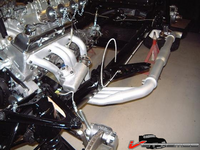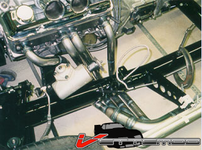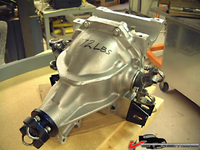Kid Vette
Master-Baiter
Tool & Die/Mold Maker and DesignerKID VETTE, what is your background?
George
Tool & Die/Mold Maker and DesignerKID VETTE, what is your background?
George
I should be able to deal with any bearing races with liners if nothing else.
As for thermal, There is not enough heat gain to cause problums.
KID VETTE, what is your background?
George
I should be able to deal with any bearing races with liners if nothing else.
As for thermal, There is not enough heat gain to cause problums.
KID VETTE, what is your background?
George
Glue the bearing sleeves in with locktite. As you say i doubt there enough expansion to loosen it up that much. Low load slow rotating application is not going to be a problem anyway even if the races slip a little.
I wouldn't have any qualms about duplicating that housing exactly (not thicker) in AL if it's going to drive power steering. The loads will not be high at all. A forged billet block of high strength AL might be just as strong as pig iron.
Lots of worry warts around. Jim has to think differently. When you're a professional engineer at a big manufacturer you have to be liability adverse out of necessity.
For hotrodders application it's just fine, but to reiterate my post above lots of effort and $$$$$ for just a few pounds. Theres got to be other more cost effective things that can save weight before doing this. There is a lot of unnecessary metal forward of the radiator. You'd probably save more weight replacing the front sway bar with a tube.
NOT that I really care all that much, but just what weight savings, if any, was there for the rack conversion....using the steeriods or VBP rack conversion....my bet it amounts to a even swap on their stuff....
but no guess for mine....;-)))
:harhar:
NOT that I really care all that much, but just what weight savings, if any, was there for the rack conversion....using the steeriods or VBP rack conversion....my bet it amounts to a even swap on their stuff....
but no guess for mine....;-)))
:harhar:
I have to think there's a net weight loss with the rack conversion. I would guess that there's a fairly equal weight between the stock p/s cylinder/ram, control valve, and the steering arms, and the weight of the GA rack. But I would think the extra linkage and u-joints needed for the conversion would be lighter than the original steering box.
Here's a couple pics I stole off the web.I think that I saw one of the Grand Sports at the Concourse de Elegance in Rochester, Michigan several years ago. As I remember I took several underhood color pictures. I will have to dig through my old 35mm slides to look for them.
Jim



